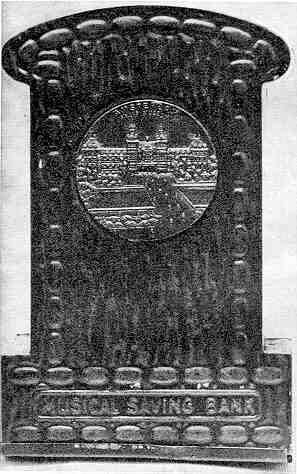The Fourth Musical Savings Bank
by F.H. Griffith - HOBBIES Magazine - January, 1967
 It would seem safe to assume since mechanical banks have been
collected for so many years now that no other mechanical bank was made using the name
Musical Saving Bank when three different types are known to exist already (see HOBBIES,
May, 1966).
It would seem safe to assume since mechanical banks have been
collected for so many years now that no other mechanical bank was made using the name
Musical Saving Bank when three different types are known to exist already (see HOBBIES,
May, 1966).
Well this isn’t the case, as there is another type, quite different from the other three, particularly appearancewise. This bank is all metal with the exception of the wood sounding base upon which the musical mechanism is mounted inside the bank. The Musical Saving Bank pictured is our choice as No. 152 in the numerical classification, although it should be numerically with the other three. There isn’t much we can do about this, however, as it is not impossible that a fifth type exists, unknown to collectors today, which could turn up at any time. This is rather unlikely but it could happen, and that’s why it’s difficult to list or class banks in any permanent order. After all, a Coasting Bank or Japanese Ball Tosser is sure to turn up sooner or later, and when this happens the bank, in either case, should be ranked far up the list. This also applies where the rarity of a bank is concerned. For example, let’s take the case of the Schley Bottling Up Cervera Bank. The first specimen of this bank turned up about 25 years ago, then to the best of the writer’s knowledge, no others were found until the past year, and in the last year’s time two others have been found! This is one of the many fascinating phases in collecting mechanical banks—you just never know what may show up next. The unpredictable and unknown factors involved are stimulating and maintain an interest level at all times—there is no point of near boredom or reaching a point where you can’t go beyond. You might say it’s almost impossible for any one person ever to own a complete collection of all known mechanical banks, but you can keep trying. And to sum this up, the purpose of the writer in the articles is to convey information on the individual mechanical banks, and in his booklet to grade them and so on in as permanent a fashion as possible. In other words, the numerical angle of the articles is not the important phase and it more or less bears out one of the writer’s favorite expressions—"there is nothing so permanent as change."
The Musical Saving Bank pictured is from the collection of Hubert B. Whiting of Wakefield, Mass. Mr. Whiting, after reading the article on the three other Musical Saving Banks, was kind enough to advise the writer of the unusual specimen in his possession. It formerly belonged to a man named Bishop who has since passed on and so no information is available beyond that point as to where Mr. Bishop obtained the bank, and so on. Fortunately on the back of the bank in the metal stamping appears "Swiss Made," and across from that "Swiss Patent No. 102591." The Swiss Patent Offices were more than completely cooperative with the writer and furnished him with an original copy of the patent through the Bureau Federal De La Propriete Intellectuelle. The patent on the Musical Saving Bank was issued to Madam Alice Reuge Ste-Croix Vaud, Suisse, March 1, 1923. The text of the patent is in French and there is a page of drawings, Figure 1 through 5, depicting the method of operation. The text goes into detail as to the music only playing upon the insertion of a coin.
The bank pictured is in fine original condition. It is a rather sturdy tin stamping in the decorative form as shown. It is painted entirely in black with a silver color medallion showing the Amsterdam Rijks Museum. To the left and back of the top of the bank there is a coin slot with the word "Coin" along the slot. On the back of the bank there is a small clock-like key. This is first wound and then a coin is dropped into the slot. The music starts and plays two pieces, The Bells of Monastery and Rigoletto. It stops automatically after both pieces are played—ready for another coin. Coins are removed by means of a key lock in the bottom base, which is hinged and opens completely. The inside of the bank is well constructed with a chute for the coins to operate the lever, and the music mechanism is completely enclosed in a metal box so there is no interference when coins accumulate inside the bank. The metal box has the wooden sounding base as previously mentioned.
In closing, it bears mention that another specimen of this bank is now known to exist, and the medallion on the front is that of an English setter in the pointing position. This example also plays two pieces, however, they are Santa Lucia and Carmen Toreador. Other than the medallion and the musical renditions, this bank and the one belonging to Mr. Whiting are identical.
